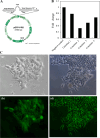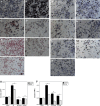Estrogenic transmembrane receptor of GPR30 mediates invasion and carcinogenesis by endometrial cancer cell line RL95-2
- PMID: 22270964
- PMCID: PMC11824201
- DOI: 10.1007/s00432-011-1133-7
Estrogenic transmembrane receptor of GPR30 mediates invasion and carcinogenesis by endometrial cancer cell line RL95-2
Abstract
Purpose: The mechanisms underlying the effects of estrogen on endometrial cancer remain undefined. Although the classical mechanism of the action of estrogen involves binding to the estrogen receptors α and β, and transduction of the signal into the cell, G protein-coupled receptor (GPR) 30 has been shown to mediate nongenomic estrogen signaling. The goal of this study was to determine the role of GPR30 signal in the basic process such as invasion and carcinogenesis of endometrial cancer.
Methods: We downregulated the expression of GPR30 in endometrial cancer cell line RL95-2 by transfection with shGPR30-pGFP-V-RS, a GPR30 antisense expression vector. The cells were then subjected to an MTT assay and a Transwell(®) migration assay. And an animal model was also used to investigate the influence of downregulation of GPR30 on oncogenesis.
Results: Downregulation of GPR30 led to reduced growth and invasion by cells treated with 17β-estradiol. And the capacity of transfected RL95-2 cells to promote tumorigenesis was weakened in vivo.
Conclusions: Our data suggest that, for the endometrial cancer cell line RL95-2, GPR30 plays important roles in mediating the proliferative and invasive effects of estrogen and in tumorigenesis.
Figures




Similar articles
-
The G protein-coupled receptor GPR30 mediates the nontranscriptional effect of estrogen on the activation of PI3K/Akt pathway in endometrial cancer cells.Int J Gynecol Cancer. 2013 Jan;23(1):52-9. doi: 10.1097/IGC.0b013e31827912b8. Int J Gynecol Cancer. 2013. PMID: 23235274
-
Estrogenic G protein-coupled receptor 30 signaling is involved in regulation of endometrial carcinoma by promoting proliferation, invasion potential, and interleukin-6 secretion via the MEK/ERK mitogen-activated protein kinase pathway.Cancer Sci. 2009 Jun;100(6):1051-61. doi: 10.1111/j.1349-7006.2009.01148.x. Epub 2009 Mar 9. Cancer Sci. 2009. PMID: 19432902 Free PMC article.
-
Assessing Estrogen-Induced Proliferative Response in an Endometrial Cancer Cell Line Using a Universally Applicable Methodological Guide.Int J Gynecol Cancer. 2018 Jan;28(1):122-133. doi: 10.1097/IGC.0000000000001121. Int J Gynecol Cancer. 2018. PMID: 28953135
-
Pre-operative endometrial thinning agents before endometrial destruction for heavy menstrual bleeding.Cochrane Database Syst Rev. 2013 Nov 15;2013(11):CD010241. doi: 10.1002/14651858.CD010241.pub2. Cochrane Database Syst Rev. 2013. PMID: 24234875 Free PMC article.
-
Could in-vitro studies on Ishikawa cell lines explain the endometrial safety of raloxifene? Systematic literature review and starting points for future oncological research.Eur J Cancer Prev. 2015 Nov;24(6):497-507. doi: 10.1097/CEJ.0000000000000107. Eur J Cancer Prev. 2015. PMID: 25536299
Cited by
-
Cytoplasmic expression of G protein-coupled estrogen receptor 1 correlates with poor postoperative prognosis in non-small cell lung cancer.J Thorac Dis. 2022 May;14(5):1466-1477. doi: 10.21037/jtd-22-29. J Thorac Dis. 2022. PMID: 35693608 Free PMC article.
-
Organs-On-Chip Models of the Female Reproductive System.Bioengineering (Basel). 2019 Nov 7;6(4):103. doi: 10.3390/bioengineering6040103. Bioengineering (Basel). 2019. PMID: 31703369 Free PMC article. Review.
-
MDH2 Stimulated by Estrogen-GPR30 Pathway Down-Regulated PTEN Expression Promoting the Proliferation and Invasion of Cells in Endometrial Cancer.Transl Oncol. 2017 Apr;10(2):203-210. doi: 10.1016/j.tranon.2017.01.009. Epub 2017 Feb 9. Transl Oncol. 2017. PMID: 28189066 Free PMC article.
-
High expression of GPR116 indicates poor survival outcome and promotes tumor progression in colorectal carcinoma.Oncotarget. 2017 Jul 18;8(29):47943-47956. doi: 10.18632/oncotarget.18203. Oncotarget. 2017. PMID: 28624786 Free PMC article.
-
Activation of GPER suppresses epithelial mesenchymal transition of triple negative breast cancer cells via NF-κB signals.Mol Oncol. 2016 Jun;10(6):775-88. doi: 10.1016/j.molonc.2016.01.002. Epub 2016 Jan 18. Mol Oncol. 2016. PMID: 26842883 Free PMC article.
References
-
- Albanito L, Madeo A, Lappano R, Vivacqua A, Rago V, Carpino A, Oprea TI, Prossnitz ER, Musti AM, Andò S, Maggiolini M (2007) G protein–coupled receptor 30 (GPR30) mediates gene expression changes and growth response to 17β-estradiol and selective GPR30 ligand G-1 in ovarian cancer cells. Cancer Res 67:1859–1866 - PubMed
-
- Baquedano MS, Saraco N, Berensztein E, Pepe C, Bianchini M, Levy E, Goñi J, Rivarola MA, Belgorosky A (2007) Identification and developmental changes of aromatase and estrogen receptor expression in prepubertal and pubertal human adrenal tissues. J Clin Endocrinol Metab 92:2215–2222 - PubMed
-
- Filardo EJ, Quinn JA, Bland KI, Frackelton AR Jr (2000) Estrogen-induced activation of Erk-1 and Erk-2 requires the G protein-coupled receptor homolog, GPR30, and occurs via trans-activation of the epidermal growth factor receptor through release of HB-EGF. Mol Endocrinol 14:1649–1660 - PubMed
-
- Filardo EJ, Quinn JA, Frackelton AR Jr, Bland KI (2002) Estrogen action via the G protein-coupled receptor, GPR30: stimulation of adenylyl cyclase and cAMP-mediated attenuation of the epidermal growth factor receptor-to-MAPK signaling axis. Mol Endocrinol 16:70–84 - PubMed
-
- Filardo EJ, Graeber CT, Quinn JA, Resnick MB, Giri D, DeLellis RA, Steinhoff MM, Sabo E (2006) Distribution of GPR30, a Seven Membrane¨CSpanning estrogen receptor, in primary breast cancer and its association with clinicopathologic determinants of tumor progression. Clin Cancer Res 12:6359–6366 - PubMed
Publication types
MeSH terms
Substances
LinkOut - more resources
Full Text Sources

